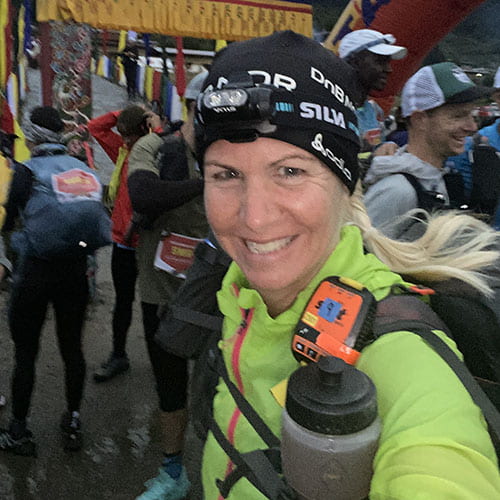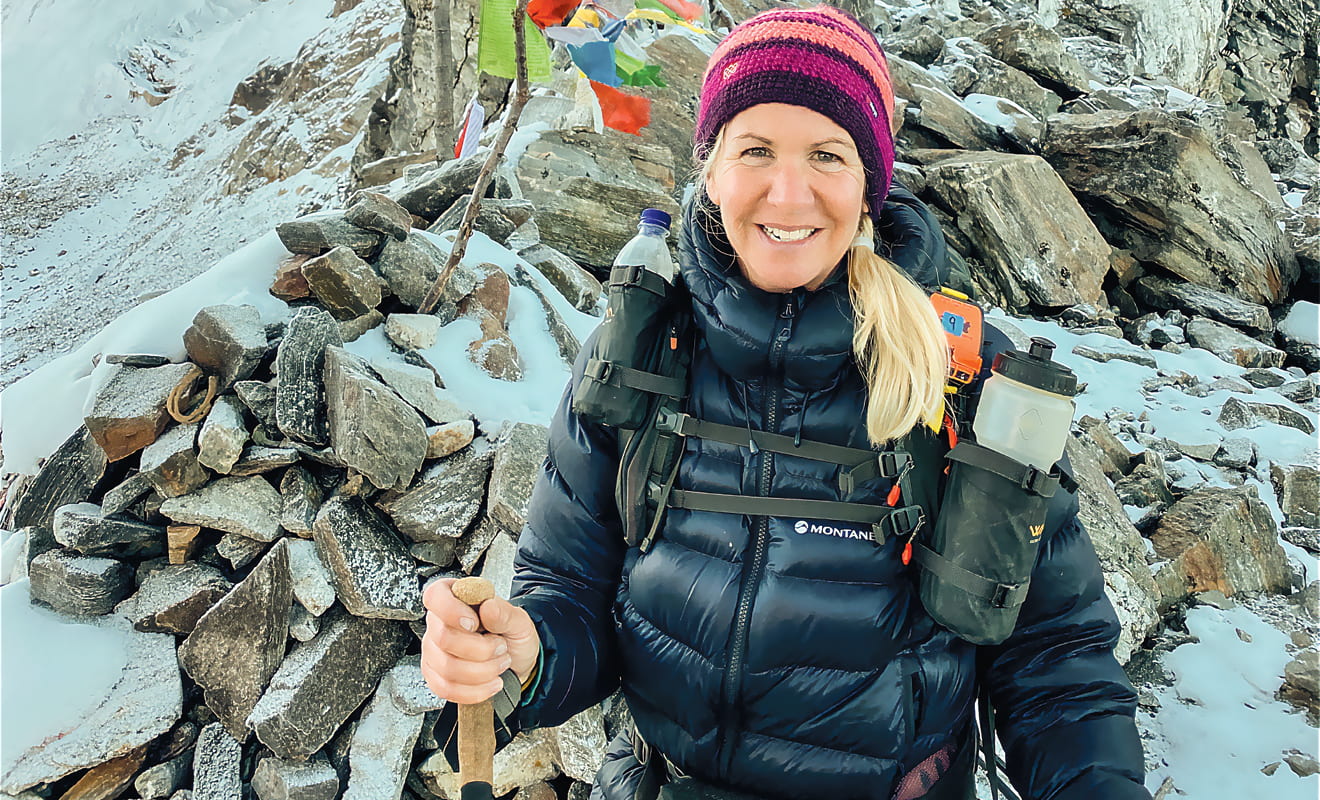Her second book, Running Everest: Adventures at the Top of the World, tells the story of how she and other runners ran a marathon that started at the Mt. Everest Base Camp—at 17,000 feet, it’s the highest marathon in the world. The beauty of the Himalayas and the life stories of her fellow runners made the experience life changing, she says. “People who do these things aren’t super athletes. They are normal people looking for adventure, and it’s really attainable for everybody, which is what I was trying to portray in the book.”
Holly Zimmermann ’91 Enjoys Pushing Limits
To understand the extreme nature of an ultramarathon, picture the already grueling distance of a typical marathon, and triple or quadruple it. Then imagine these multi-day races under the most challenging conditions, such as in the intense heat of the Sahara Desert or the bitter cold of the world’s highest mountains, where runners test their physical and mental limits while flirting with disaster—from a potential misstep on an Alps ridgeline to disorientation caused by high-altitude sickness.
This is a world where Holly Zimmermann thrives.
A former engineer turned extreme athlete, blogger, book author, and motivational speaker, Zimmermann now shares with others the lessons she’s learned—and continues to learn—from her unusual passion. Her most important message: anyone can do what she does, if they have the will.
“I always say, 90 percent of ultramarathoning is mental, and the other 10 percent is also mental,” she says. “As long as you’re physically prepared on the starting line, it’s a head game. Once you’ve reached a certain point and you think you can’t go farther, you have to get your head straight because you can accomplish it. The body … we can push it a lot farther than we think.”
Holly ZimmermannI always say, 90 percent of ultramarathoning is mental, and the other 10 percent is also mental.
Going strong at age 52, Zimmermann has the credentials to be considered one of the best in this extreme sport. She was the first international woman to finish the 2018 Mt. Everest Marathon in Nepal and was one of 20 athletes invited to participate in the inaugural Snowman Race in Bhutan in 2022. Among other events, she’s completed the 257-km (160-mile) Marathon des Sables in Morocco and the Polar Circle Marathon in Greenland—and she’s been on adventure race teams (combining running with hiking, biking, and kayaking) that have competed in national and world championships, all when she was over 50 and her teammates were in their 30s.
She credits her numbers-oriented mind—plus acquiring a GPS watch—with drawing her to races that are faster, longer, and more adventurous.
“Running marathons on the road wasn’t cutting it for me. I live in southern Germany, not too far from the Alps, and there’s a lot of trail running here. I love the trails, the nature, seeing the beauty around me. I’m always pushing my limits and seeing how much is really in me,” she says. “And it seems like I haven’t found it yet.”
An Athletic Start
Always athletic in her youth, Zimmermann competed on the lacrosse and field hockey teams at WPI. The mechanical engineering major admits she studied hard, partied often, and “took in everything I could” while a student. Her Major Qualifying Project involved a heat transfer analysis of a canister that was going into orbit on the Space Shuttle.
After graduation, she earned a master’s degree in mechanical engineering from the University of Rhode Island and took a job at AEL Industries in Virginia working on antennas and radar jamming equipment for fighter aircraft. She married and moved to her husband’s home country of Germany, where she worked as a freelance editor for technical journals while raising four children.
After the birth of her fourth child, she decided to get back into shape and soon caught the ultramarathoning bug. Preparing for her first major multi-day race (2016 Marathon des Sables in the Sahara Desert), she found there was a dearth of information about what to expect.
“We were going to be in the desert for seven days and you had to carry everything on your back that you needed for the entire week, except for water—all your food, gear, clothing. But there wasn’t that much information out there about how to prepare,” she says. That was her inspiration for writing her first book, Ultramarathon Mom, from the Sahara to the Arctic, which evolved from a daily journal she kept before and during the race, and includes stories from subsequent races and her personal life.

In her motivational speeches, she uses her own experiences to inspire others to push their
own limits.
“When I give my talks, I like to tell people, ‘everything is possible. If you have the desire to push your limits, you have everything you need,’” she says. “I describe the feeling of what it’s like running on a single track trail, feeling the grass and seeing the trees and the views, and finishing exhausted and empty, and how the chaos in your head is quelled. When you talk with passion about something that you love, that’s inspiring just as it is.”
Zimmermann’s children are her biggest supporters—two of them were part of her crew for an ultramarathon she ran in September 2022, following her in a car with everything she needed and cheering her on as she crossed the finish line as the second woman. But that doesn’t mean her family completely understands her passion.
“I don’t see any limitations,” she says. “My mother asked me recently, ‘When are you going to retire from these crazy races?’ I told her, ‘I love it, so I won’t stop unless I have to.’”
Follow Zimmermann’s blog: www.hollyzimmermann.com.






